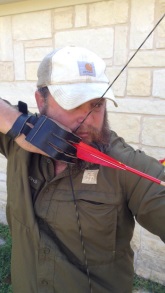LISTEN TO THE PODCAST HERE:
What it’s like to hunt whitetails down in Texas, Mr. Jeff Tucker a longbow specialist

Welcome to another edition of Whitetails Rendezvous. This is your host, Bruce Hutcheon, and we’re heading down to Texas today. And we’re going to meet with a gentleman and listen to a gentleman tell some stories about what it’s like to hunt whitetails down in Texas, Mr. Jeff Tucker a longbow specialist. Jeff, welcome to the show.
Jeff: Hey, Bruce. It’s great to be here.
Bruce: Hey, in the warm up, we were talking about you developing a new parcel of ground, a ranch down there in Texas. Why don’t we start to show off and just share what you’re doing, why you’re doing it and how are you doing it?
Jeff: Oh, sure. Yeah, so we’ve recently gotten our wildlife management permit through Texas Parks and Wildlife, and we’re only on about a couple hundred acres out here. And I say, “Only a couple hundred,” but it’s incredible how anything between 40 and up is a lot more work than you really anticipate. But we’ve been…part of our requirement with the state is to make sure that we’re clearing a certain amount of brush each year, so we’ve being doing that. Creating forage for the wildlife, and then obviously we’re putting in food supplies strategically in certain areas, and then a bigger thing out here where we’re at is water. Until recently we’ve been in about 10 or 12 year drought.
And just to give you an idea of rain, last week we had 11 inches of rain in one day which is unheard of for this area.
Bruce: Oh, my goodness.
That’s about 100 year event. The previous week before that we got 17 inches of rains
Jeff: That’s about 100 year event. The previous week before that we got 17 inches of rain, so now all the lakes are filled up and all of the areas for water are filled up, and I’ve been building some dams and then some water rendezvous spots for whitetail, and turkey, and quail, etc. So I’ve been just trying to be very strategic about not doing too much to the land that would alter it but improve it, and that’s our guideline and our hope.
Bruce: Now do you have a deer management land plan?
Jeff: Yeah, the state gives us a very stringent and specific plan that they want to see and require, so one of the things where you will clear five acres of land each year. When I got this place, the chinery [SP] growing back there, you could stand on a horse and still not touch the top of it, so I’ve done a lot of clearing to create, not only food plot, but more open habitat for the deer while maintaining a lot of it too, so that they’ve got normal cover. We’ve got cattle out here as well. Not a lot of cattle. I’m running about 20 head, which is probably pushing the boundaries out here, but we move those cattle quite a bit, and then what I’ll end up doing before the season is really backing off on the cattle, because I want this parcel of land to be more about wildlife than looking at cows and eating beef.
Bruce: How do you keep the feral hogs off your land?
Jeff: Hogs are a big deal here in Texas, but I’m actually in a sweetheart spot of a very large parcel of land the per gram for me is 7,000 acres. Now they had a lot of feral hogs, and they’ve been…obviously hunters but we’re starting to get a little bit better control on that, just because the ranchers and hundreds in this area, especially the recreation landowners are making sure that we’ve got a better handle on what they’re doing and how many of them have caused damage and where certain areas they are congregating so that we can take care of them.
Bruce: Yeah, I would think because of all the rain that’s going to concentrate, if that’s the right word, some of those herds of hogs and might make it a little bit easier to help reduce the numbers.
